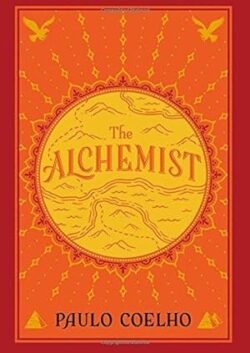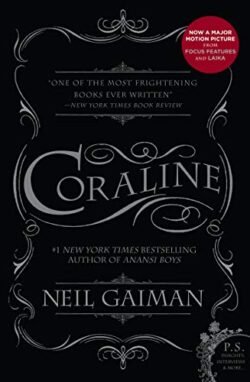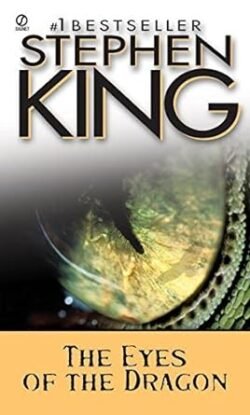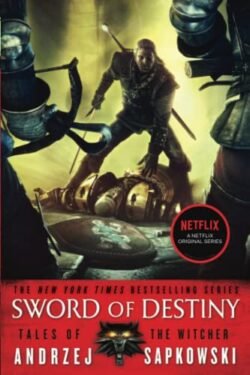“The Alchemist” by Paulo Coelho, first published in 1988, is a globally celebrated novel that delves into the journey of self-discovery and pursuing one’s dreams. It tells the story of Santiago, a young Andalusian shepherd, who dreams of finding a worldly treasure located somewhere beyond the Egyptian pyramids. Encouraged by a mysterious king, Santiago embarks on a quest that leads him to encounter love, danger, and adventure, ultimately discovering the treasure within himself. The novel is renowned for its allegorical simplicity, profound wisdom, and universal themes of following one’s destiny, the interconnectedness of all things, and the importance of listening to one’s heart. Themes and Analysis Santiago: Santiago is characterized by his curiosity, determination, and willingness to follow his dreams. His journey from a simple shepherd to a wise man who understands the language of the world serves as an inspiration to embrace one’s personal legend. Themes and Analysis Personal Legend: A central theme is the concept of the “Personal Legend,” or one’s destiny. The novel suggests that fulfilling one’s personal legend is the ultimate path to happiness and fulfillment. The Unity of Nature: Santiago learns that all of nature, from the desert sands to the stars, is interconnected, and understanding this unity is key to realizing one’s place in the world. The Value of Dreams: “The Alchemist” emphasizes the importance of dreams as a guide to one’s destiny and the necessity of listening to one’s heart to achieve true success and happiness. “The Alchemist” by Paulo Coelho is more than just a novel; it’s a philosophical guide that encourages readers to search for their own path, to believe in the journey of their dreams, and to understand that life’s greatest treasures are often found along the way, not necessarily at the destination. Its enduring popularity and widespread acclaim lie in its ability to resonate with the aspirations and dreams of individuals across different cultures and backgrounds, making it a timeless testament to the transformative power of our dreams and the importance of listening to our hearts. If the summary caught your interest, Consider reading the full book on AbeBooks. Explore this book on AbeBooks
Storm Front
“Storm Front” by Jim Butcher, published in 2000, is the first novel in the Dresden Files series. It introduces readers to Harry Dresden, the only wizard listed in the Chicago phone book and a private investigator who consults for the police department on cases involving the supernatural. In “Storm Front,” Dresden is called to investigate a series of brutal murders that appear to be executed with black magic, leading him into the heart of Chicago’s occult underworld. As Dresden tries to solve the case, he navigates a dangerous world of mobsters, vampires, and other magical beings, all while dealing with the White Council of Wizards, which oversees the practices of magic and does not look kindly on those who break the rules. Dresden must use all his wits and magical skills to solve the murders without breaking the laws of magic or becoming the killer’s next victim. Character Analysis Harry Dresden: Harry Dresden is characterized by his sharp wit, strong moral compass, and deep sense of duty to protect the innocent. Despite his often cynical outlook, Dresden’s inherent goodness and willingness to risk his life for others define his role as a hero in the series. Themes and Analysis The Intersection of the Mundane and Magical: “Storm Front” explores the coexistence of the everyday world with the supernatural, examining how these realms intersect and affect each other. Moral Ambiguity and Ethical Choices: Dresden’s navigation of complex moral landscapes, especially regarding the use of magic, highlights themes of responsibility and the consequences of one’s actions. Isolation and Community: Dresden’s isolation from both the mundane and magical communities, coupled with his connections to a few key allies, speaks to themes of loneliness, friendship, and the importance of finding one’s place in the world. “Storm Front” sets the stage for the Dresden Files series with its compelling mix of detective noir and urban fantasy. Jim Butcher creates a richly imagined world where magic is real but hidden, and the protagonist, Harry Dresden, stands at the crossroads of the human and supernatural worlds. The novel not only offers a thrilling mystery but also introduces a complex hero whose adventures will continue to explore the depths of magic, power, and the human spirit. If the summary caught your interest, Consider reading the full book on AbeBooks. Explore this book on AbeBooks
Coraline
“Coraline” by Neil Gaiman, first published in 2002, is a dark fantasy novel that has captivated readers of all ages with its imaginative storytelling and haunting atmosphere. The story follows Coraline Jones, a young girl who discovers a secret door in her new home that leads to an alternate universe. This other world initially seems like a better version of her own, with attentive parents and exciting discoveries. However, Coraline soon realizes that this parallel place harbors dark secrets and sinister intentions, particularly in the form of the Other Mother, a malevolent entity who wants to keep Coraline forever. As Coraline courageously fights to save herself and other trapped souls, the novel explores themes of bravery, the importance of self-identity, and the meaning of home. Gaiman’s rich prose and the story’s eerie undertones make “Coraline” a compelling read that challenges the boundaries between the whimsical and the macabre. Character Analysis Coraline Jones: Coraline is portrayed as an adventurous, curious, and remarkably brave girl. Her journey in the novel highlights her growth from feeling neglected and bored to discovering her inner strength and the value of appreciating her own reality. The Other Mother: The Other Mother, also known as the Beldam, is the antagonist of the story. She is a shape-shifting entity that lures children into her world to trap them. Her character embodies themes of manipulation and the deceptive allure of seemingly perfect worlds. Themes and Analysis Courage and Resourcefulness: “Coraline” celebrates the protagonist’s bravery and ingenuity as she confronts fears and challenges far beyond her years. The Illusion of Perfection: The novel critiques the pursuit of a flawless existence, showcasing the dangers of being seduced by superficially ideal alternatives to the complexities of real life. The Power of Free Will: Coraline’s ability to make choices, question her surroundings, and reject the Other Mother’s manipulations is central to the narrative, underscoring the importance of autonomy and self-determination. Neil Gaiman’s “Coraline” is a modern classic that blends fairy tale elements with psychological horror to create a uniquely captivating story. Its success lies not only in its ability to entertain and frighten but also in its profound exploration of what it means to face one’s fears and appreciate the often imperfect beauty of one’s own world. The novel’s enduring appeal is evidenced by its adaptation into various other media, including a critically acclaimed stop-motion film, ensuring that Coraline’s tale continues to enchant and inspire new generations of readers and viewers. If the summary caught your interest, Consider reading the full book on AbeBooks. Explore this book on AbeBooks
The Nightingale
“The Nightingale” by Kristin Hannah, published in 2015, is a poignant historical fiction novel set in France during World War II. The story captures the resilience, courage, and sacrifices of two sisters, Vianne Mauriac and Isabelle Rossignol, as they navigate the challenges and horrors of the German occupation. Vianne, a teacher and mother, must fight to protect her home and daughter when her husband is taken prisoner. Meanwhile, Isabelle, impulsive and rebellious, becomes involved in the French Resistance, risking her life to save others. “The Nightingale” explores themes of love, war, family, and the extraordinary acts of heroism that ordinary people can perform in the darkest times. Character Analysis Vianne Mauriac: Vianne represents resilience and the struggle to maintain normalcy and protect her loved ones in the face of war. Her character development throughout the novel showcases her transformation from a passive observer of the war to an active participant in survival and resistance. Isabelle Rossignol: Isabelle embodies the spirit of defiance and courage. Her work with the Resistance highlights the role of women in wartime and the capacity for individuals to make a significant impact despite overwhelming odds. Themes and Analysis The Strength of Women in War: “The Nightingale” emphasizes the often-overlooked role of women during WWII, showcasing their strength, bravery, and contributions to the war effort. Sacrifice and Survival: The novel explores the sacrifices made by individuals during times of conflict, both on the battlefield and the home front, highlighting the complexity of survival and moral choices in war. Love and Loss: At its heart, the story is also about love—romantic, familial, and platonic—and the deep losses endured by those living through the war. “The Nightingale” is a tribute to the silent heroes of World War II, particularly the women who fought their own battles within the occupied territories. Kristin Hannah’s evocative storytelling and well-drawn characters offer a moving and immersive experience, shedding light on the courage and resilience of those who lived through one of history’s darkest periods. The novel has resonated with readers worldwide, earning acclaim for its detailed research, emotional depth, and its celebration of the human spirit’s capacity to persevere and resist in the face of overwhelming adversity. If the summary caught your interest, Consider reading the full book on AbeBooks. Explore this book on AbeBooks
The Eyes of the Dragon
“The Eyes of the Dragon” by Stephen King, published in 1987, marks a departure from the author’s usual horror genre, delving instead into the realm of fantasy and adventure. Set in the fictional realm of Delain, part of King’s larger multiverse, the novel tells the story of a kingdom thrown into chaos by the machinations of a malevolent wizard named Flagg. The plot centers around two princes, Peter and Thomas, who are the sons of King Roland. After the king’s mysterious death, which is secretly orchestrated by Flagg, the elder prince, Peter, is wrongfully imprisoned for the murder, leaving the younger and more impressionable Thomas to ascend the throne under Flagg’s sinister influence. The narrative unfolds as a classic tale of good versus evil, with young Peter’s journey to prove his innocence and reclaim his rightful place on the throne, aided by a loyal group of friends and the mysterious powers of a magical artifact known as “the eyes of the dragon.” Character Analysis Peter: Peter, the elder prince, is characterized by his courage, intelligence, and inherent sense of justice. Wrongfully accused and imprisoned, his resilience and determination to reclaim his throne highlight his growth from a boy to a leader. Thomas: Thomas, the younger prince, initially struggles with feelings of inadequacy and jealousy towards his brother. Under Flagg’s influence, he becomes king but is tormented by guilt and doubt, leading to his complex development throughout the story. Flagg: Flagg, the antagonist, is a dark and manipulative wizard whose ultimate goal is to bring ruin to Delain. His character embodies the archetypal evil sorcerer, using deceit and dark magic to achieve his ends. Themes and Analysis The Battle Between Good and Evil: The novel explores the timeless theme of good versus evil, embodied in the conflict between Peter and Flagg. The Journey of Maturation: Through the trials they face, both Peter and Thomas undergo significant personal growth, highlighting themes of maturity, responsibility, and the search for one’s identity. Power and Corruption: “The Eyes of the Dragon” delves into how power can corrupt, as seen through Thomas’s struggles as king and Flagg’s manipulations to gain control of the kingdom. “The Eyes of the Dragon” stands out as a unique entry in Stephen King’s bibliography, offering readers a richly crafted fantasy world filled with intrigue, magic, and the struggle for power. Its departure from horror showcases King’s versatility as a storyteller, weaving a tale that is as much about the characters’ internal journeys as it is about their external adventures. With its engaging plot, complex characters, and exploration of universal themes, the novel is a compelling read for both fans of Stephen King and lovers of fantasy fiction alike. If the summary caught your interest, Consider reading the full book on AbeBooks. Explore this book on AbeBooks
Alaska
“Alaska” by James A. Michener, published in 1988, is an epic historical novel that spans thousands of years, tracing the history of Alaska from the prehistoric era through the end of the 20th century. Michener, known for his exhaustive research and ability to weave factual history with engaging narrative, tells the story of Alaska’s development through a series of interconnected tales involving the region’s indigenous peoples, explorers, settlers, and later inhabitants. The novel covers significant events and periods in Alaska’s history, including the migration of Native American tribes across the Bering Land Bridge, the impact of Russian colonization, the Alaska Gold Rush, and the state’s strategic role during World War II. Michener explores the harsh yet majestic landscapes of Alaska, its vast resources, and the diverse cultures that have called it home, all while examining the themes of survival, conflict, and coexistence in this formidable environment. Character Analysis As “Alaska” is a work of historical fiction, it features a wide array of characters from different eras, each contributing to the rich tapestry of the state’s history. These characters, both fictional and based on real historical figures, embody the spirit of adventure, resilience, and ambition that defines Alaska. From native Inuit and Tlingit tribes to Russian fur traders, gold miners, and American soldiers, each character’s story provides insight into the challenges and opportunities presented by the Alaskan wilderness. Themes and Analysis Human Interaction with Nature: A central theme of “Alaska” is the relationship between humans and the natural environment. Michener vividly depicts how Alaska’s geography and climate have shaped the lives of its inhabitants and their activities, from subsistence hunting and fishing to the exploitation of its natural resources. Cultural Convergence and Conflict: The novel examines the interactions among Alaska’s diverse cultural groups, highlighting moments of both cooperation and conflict. It explores the impact of colonization, the clash of civilizations, and the blending of traditions that characterize the state’s history. Change and Continuity: Through its sweeping historical scope, “Alaska” reflects on the forces of change that have transformed the region, as well as the enduring aspects of its identity. Michener addresses issues of sovereignty, economic development, and political change, all while paying homage to the timeless beauty of the Alaskan landscape. James A. Michener’s “Alaska” is a monumental work that captures the essence of a region marked by its vastness, beauty, and complexity. Through detailed historical research and compelling storytelling, Michener offers readers a panoramic view of Alaska’s evolution, from its earliest inhabitants to modern times. The novel is not only a tribute to the state’s rich history and cultural diversity but also a reflection on the broader themes of human endurance, the quest for prosperity, and the impact of human activities on the environment. “Alaska” remains an essential read for anyone interested in the history of this unique and captivating part of the world. If the summary caught your interest, Consider reading the full book on AbeBooks. Explore this book on AbeBooks
Love in the Time of Cholera
“Love in the Time of Cholera” by Gabriel García Márquez, first published in 1985, is a masterpiece of magical realism that explores themes of love, desire, and aging over a span of fifty years. Set in an unnamed Caribbean seaport city, the novel tells the story of the long, unrequited love between Florentino Ariza and Fermina Daza. Florentino falls deeply in love with Fermina in their youth, but she eventually marries a wealthy doctor, Juvenal Urbino, instead. The novel follows their lives through the decades, detailing Florentino’s numerous romantic encounters and his unwavering devotion to Fermina, culminating in their reunion in old age after Urbino’s death. Themes and Analysis Florentino Ariza: Florentino Ariza is characterized by his romantic idealism and obsessive love for Fermina Daza. Despite being rejected, he vows to remain faithful to her, engaging in various affairs yet holding onto the promise of his youthful love. His life is marked by his poetic view of love and his determination to wait for the chance to be with Fermina again. Fermina Daza: Fermina Daza is initially drawn to Florentino’s passionate advances but ultimately chooses stability and social status in her marriage to Juvenal Urbino. Her character is strong-willed and practical, yet as she ages, she reflects on her choices and the meaning of love and companionship. Juvenal Urbino: Dr. Juvenal Urbino, Fermina’s husband, is a symbol of modernity and progress in the city. His marriage to Fermina is characterized by mutual respect and affection, but it lacks the passionate intensity of Florentino’s love. Urbino’s death sets the stage for the novel’s conclusion and the possibility of a second chance for Florentino and Fermina. Themes and Analysis The Nature of Love: The novel presents a complex exploration of love’s many forms, from youthful passion to marital companionship, and questions the nature of true love and fidelity. Time and Memory: García Márquez examines how time affects characters’ perceptions and emotions, exploring themes of memory, aging, and the inevitability of death. Social Class and Progress: The backdrop of the changing seaport city reflects the tensions between tradition and modernity, and the impact of social class on characters’ lives and relationships. “Love in the Time of Cholera” is a poignant meditation on the enduring power of love, masterfully blending the real with the magical. Gabriel García Márquez’s lyrical prose and richly drawn characters create a vivid tapestry of life’s complexities, making it a landmark novel in world literature. The book’s exploration of love’s many facets, coupled with its deep humanity and understanding of the human heart, continues to resonate with readers around the world, cementing its status as a timeless classic. If the summary caught your interest, Consider reading the full book on AbeBooks. Explore this book on AbeBooks
Sword of Destiny (The Witcher)
“Sword of Destiny” is the second book in “The Witcher” series by Polish author Andrzej Sapkowski, first published in 1992. It is a collection of six short stories that further explore the adventures of Geralt of Rivia, a Witcher with supernatural abilities who hunts monsters for a living. The stories delve into Geralt’s complex relationships, moral dilemmas, and the destiny that binds him to Ciri, a child of prophecy who holds the power to change the world. Through these narratives, Sapkowski expands the richly detailed universe of “The Witcher,” blending elements of Slavic mythology, traditional fantasy, and philosophical reflection. Themes and Analysis Geralt of Rivia: Geralt is a Witcher, a monster hunter who has undergone extensive training and magical enhancements. Known for his prowess in combat and his signature white hair, Geralt is a morally complex character, often caught between the lesser of two evils. His stoic exterior belies a deep sense of ethics and a conflicted heart, as he navigates a world where humans can be more monstrous than the creatures he hunts. Themes and Analysis Destiny and Choice: A recurring theme in “Sword of Destiny” is the interplay between destiny and free will. Geralt’s skepticism of destiny is challenged as he encounters individuals and events that suggest his fate is intertwined with Ciri’s. Nature of Humanity: Sapkowski uses the backdrop of a fantasy world to explore the nature of humanity, examining themes of prejudice, love, and the capacity for both kindness and cruelty. Environmentalism and Balance: Several stories in the collection touch on the relationship between humans and the natural world, highlighting the consequences of environmental degradation and the importance of maintaining balance. “Sword of Destiny” is a critical work in “The Witcher” series, providing key background and depth to the saga’s central characters and themes. Andrzej Sapkowski’s storytelling is both engaging and thought-provoking, offering readers a blend of action, intrigue, and philosophical musing. The collection is essential reading for fans of “The Witcher,” providing a deeper understanding of Geralt’s world and the forces that shape his destiny. As part of a beloved fantasy series, “Sword of Destiny” stands out for its rich character development, moral complexity, and its exploration of timeless themes through the lens of a meticulously crafted fantasy universe. If the summary caught your interest, Consider reading the full book on AbeBooks. Explore this book on AbeBooks
The Storyteller
“The Storyteller” by Jodi Picoult, published in 2013, is a compelling novel that delves deep into the themes of morality, forgiveness, and the enduring impact of the past on the present. The narrative centers around Sage Singer, a young woman who befriends an elderly man named Josef Weber in her grief support group. Their unlikely friendship takes a dark turn when Josef confesses to being a former SS officer at Auschwitz, seeking Sage’s forgiveness for his past atrocities. Sage, whose grandmother Minka is a Holocaust survivor, finds herself torn between the desire for justice and the complex nature of forgiveness. The novel weaves together multiple perspectives, including Sage’s, Josef’s, and Minka’s, who shares her harrowing tale of survival through the Holocaust. Minka’s story within the story, a fictional account of a Polish girl’s experience in the ghettos and concentration camps, adds a profound layer of historical depth and emotional resonance to the narrative. Character Analysis Sage Singer: Sage is a baker who prefers the solitude of night, where she can hide her scarred face and the guilt she carries for her mother’s death. Her character embodies themes of self-imposed isolation and the struggle with self-forgiveness. Sage’s journey through the novel is one of moral reckoning and personal transformation as she confronts Josef’s request and her grandmother’s past. Josef Weber: Josef is introduced as a beloved, elderly community member with a horrifying secret. His character challenges readers to grapple with the question of whether someone who has committed unspeakable evils can ever truly atone for their actions. Josef’s presence in the novel provokes a deep examination of guilt, remorse, and the possibility of redemption. Minka Minka’s: story provides a direct link to the Holocaust, serving as a testament to the resilience of the human spirit in the face of unimaginable horror. Through Minka, the novel explores themes of survival, the power of storytelling, and the ways in which personal history shapes one’s identity. Themes and Analysis The Complexity of Forgiveness: The novel poses challenging questions about the limits of forgiveness and its role in the healing process, both for individuals and communities. Memory and Storytelling: “The Storyteller” highlights the importance of memory and storytelling in preserving history, conveying truths about the human condition, and seeking justice. The Moral Ambiguity of Justice: Picoult explores the moral ambiguity surrounding justice, especially in cases of historical atrocities, and the responsibilities of subsequent generations to remember and respond to the past. “The Storyteller” by Jodi Picoult is a thought-provoking exploration of the darkest chapters of human history, the enduring quest for justice, and the deeply personal journey toward understanding and forgiveness. Through its multifaceted characters and interwoven narratives, the novel captures the complexity of confronting the past and the moral dilemmas that arise when seeking to reconcile the irreconcilable. Picoult masterfully crafts a story that is as unsettling as it is moving, compelling readers to reflect on the nature of evil, the capacity for change, and the power of forgiveness. If the summary caught your interest, Consider reading the full book on AbeBooks. Explore this book on AbeBooks
Beach Music
“Beach Music” by Pat Conroy, published in 1995, is a sprawling novel that delves into themes of family, loss, and redemption. Set against the backdrop of the South Carolina lowcountry and the historic vistas of Rome, the story follows Jack McCall, an American expatriate living in Italy with his young daughter after the tragic suicide of his wife. Jack’s self-imposed exile is interrupted when he is called back to South Carolina by his mother’s impending death. The return to his homeland forces Jack to confront his tumultuous past, including a fractured family, the shadow of the Vietnam War, and the deep wounds left by his wife’s death. As Jack navigates his complex family dynamics and the secrets that emerge, “Beach Music” weaves a rich tapestry of characters and stories that span continents and generations. Character Analysis Jack McCall: Jack McCall is the protagonist, a deeply wounded man who has fled his past and the pain associated with his home. His journey back to South Carolina and the subsequent reconciliation with his family and friends serve as the central narrative arc, exploring themes of forgiveness, understanding, and healing. Jack’s character is marked by his resilience in the face of tragedy and his capacity for love and forgiveness. Themes and Analysis The Complexity of Family: “Beach Music” explores the intricate web of relationships within the McCall family, highlighting the challenges and beauty of familial bonds. Conroy examines the ways in which families can be both a source of deep pain and profound healing. The Impact of History and War: The novel addresses the lingering effects of the Vietnam War on its veterans and their families, as well as the Holocaust’s legacy through the character of Leah, whose family history unfolds in the narrative. Grief and Redemption: At its heart, the story is about dealing with grief, finding redemption, and the possibility of starting anew. Conroy portrays the characters’ struggles with loss and their paths toward healing with empathy and depth. “Beach Music” by Pat Conroy is a masterful exploration of the human condition, set against the richly described landscapes of South Carolina and Rome. Conroy’s lyrical prose and deep emotional insight into his characters make the novel a poignant and compelling read. The book’s examination of the complexities of life, family, and history captures the essence of the American South and the universal quest for meaning and reconciliation. “Beach Music” remains a beloved work in Conroy’s oeuvre, celebrated for its storytelling, character development, and the evocative beauty of its settings. If the summary caught your interest, Consider reading the full book on AbeBooks. Explore this book on AbeBooks










